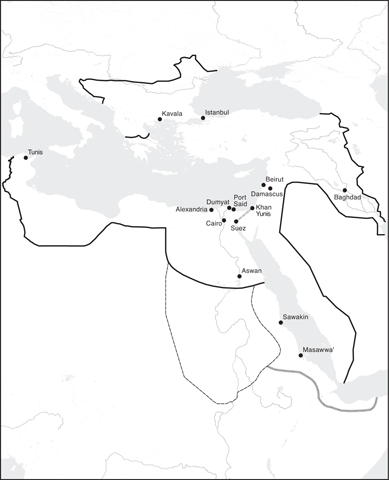
Notes on Transliteration, Names, Titles, and Currency
Arabic words are transliterated following the system of the International Journal of Middle East Studies (IJMES) without the initial hamza. Colloquial Egyptian Arabic expressions are transcribed according to their pronunciation in today’s Cairo. Ottoman Turkish is transliterated according to the modern Turkish alphabet and pronunciation. Arabic or Turkish words found in the Oxford Dictionary of English are used accordingly (Koran, not Qurʾān; sheikh, not shaykh). Muslim months and days are transliterated according to Arabic vocalization, following the IJMES standard (Rajab and not Turkish Receb or Raceb; jumʿa, not cuma).
Where a person gave his or her name in Latin script consistently, I have respected that practice (e.g., Fahmy); however, I have made some exceptions (Khayyāṭ, not Kaïat; Qardāḥī, not Cardahi) to maintain consistency with the earlier literature. In the case of elite Ottomans in Egypt, I transcribe their names according to the Ottoman Turkish conventions (Khedive Ismail, not Ismāʿīl; Said, not Saʿīd). The names of those, like Ismāʿīl Ṣiddīq, who are remembered as Egyptians are transcribed according to the Arabic. Where a military or administrative title has an English equivalent I have used it (Pasha and not Pacha, Paşa, or Bāshā; Bey, not Bīk). “Efendi,” after Ryzova, is written without the double f.
In this period, 1 Egyptian pound (ghinī, LE = livre égyptienne) was 100 piasters (qirsh/ghirsh, qurush/ghurūsh), and 1 piaster was equivalent to 40 paras. Currency exchange rates vary. In 1875, 1 British pound (“sovereign”) was equivalent to 195 piasters (1.95 LE); 1 French franc was 7 piasters 20 paras. (Murray, A Handbook, 8–9.) In 1878, 1 French franc was 3.8 piasters (table 3.2). In 1885, 1 LE was 26 francs (Baedeker’s Lower Egypt [1885], 5).
FIGURE I.1. The Ottoman Empire, 1860s
THE solid black line indicates the approximate boundaries of the Ottoman Empire in the early 1860s. The dashed line indicates the approximate boundaries of the Ottoman-Egyptian sphere of the Sudan after the conquests of Mehmed Ali and his descendants. The double-dashed line indicates the boundary of the Egyptian province in the Sinai according to the 1841 firman. The shaded-dotted line indicates the approximate additions in Africa to Ottoman-Egyptian sphere of interest in the mid-1860s.
Source: Map prepared prepared by Fei Carnes, Harvard Center for Geographical Analysis.
Copyright © Fei Carnes.
FIGURE I.2. The Rulers of Egypt